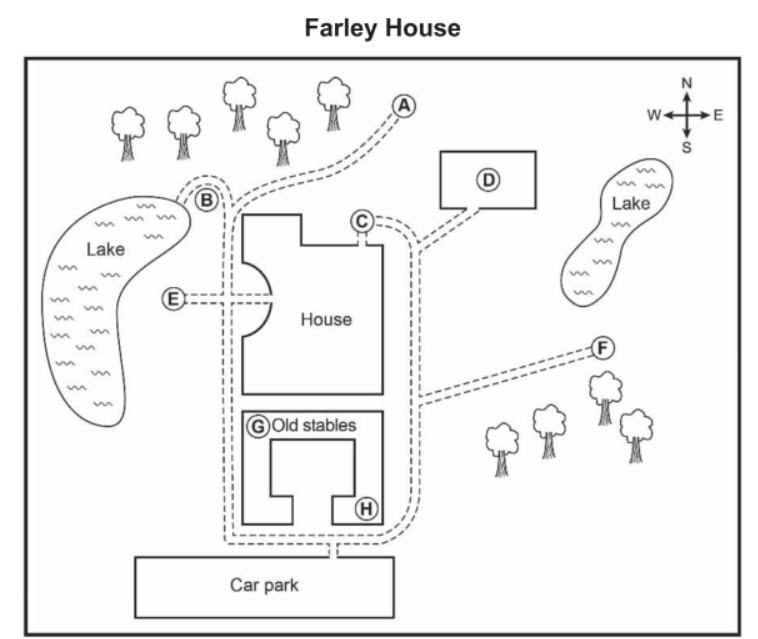Complete the notes below. Write ONE WORD AND/OR A NUMBER for each answer.
Hinchingbrooke Country Park
The park
Area: (1) hectares
Habitats: wetland, grassland and woodland
Wetland: lakes, ponds and a (2)
Wildlife includes birds, insects and animals
Subjects studied in educational visits include
Science: Children look at (3) about plants, etc.
Geography: includes learning to use a (4) and compass
History: changes in land use
Leisure and tourism: mostly concentrates on the park’s (5)
Music: Children make (6) with natural materials, and experiment
with rhythm and speed.
Benefits of outdoor educational visits
They give children a feeling of (7) that they may not have elsewhere.
Children learn new (8) and gain self-confidence.
Practical issues
Cost per child: (9) £
Adults, such as (10) , free
Choose the correct letter, A, B or C.
Stanthorpe Twinning Association
11. During the visit to Malatte, in France, members especially enjoyed
A going to a theme park.
B experiencing a river trip.
C visiting a cheese factory.
12. What will happen in Stanthorpe to mark the 25th anniversary of the Twinning Association?
A A tree will be planted.
B A garden seat will be bought.
C A footbridge will be built.
13. Which event raised most funds this year?
A the film show
B the pancake evening
C the cookery demonstration
14. For the first evening with the French visitors host families are advised to
A take them for a walk round the town.
B go to a local restaurant.
C have a meal at home.
15. On Saturday evening there will be the chance to
A listen to a concert.
B watch a match.
C take part in a competition.
Label the map below. Write the correct letter, A-H, next to Questions 16-20.

16. Farm shop
17. Disabled entry
18. Adventure playground
19. Kitchen gardens
20. The Temple of the Four Winds
Choose TWO letters, A-E.
Which TWO things did Colin find most satisfying about his bread reuse project?
A receiving support from local restaurants
B finding a good way to prevent waste
C overcoming problems in a basic process
D experimenting with designs and colors
E learning how to apply 3-D printing
Choose TWO letters, A-E.
Which TWO ways do the students agree that touch-sensitive sensors for food labels could be developed in future?
A for use on medical products
B to show that food is no longer fit to eat
C for use with drinks as well as foods
D to provide applications for blind people
E to indicate the weight of certain foods
What is the students’ opinion about each of the following food trends? Choose SIX answers from the box and write the correct letter, A-H, next to Questions 25-30.
Opinions
A This is only relevant to young people.
B This may have disappointing results.
C This already seems to be widespread.
D Retailers should do more to encourage this.
E More financial support is needed for this.
F Most people know little about this.
G There should be stricter regulations about this.
H This could be dangerous.
Food trends
25. Use of local products
26. Reduction in unnecessary packaging
27. Gluten-free and lactose-free food
28. Use of branded products related to celebrity chefs
29. Development of ‘ghost kitchens’ for takeaway food
30. Use of mushrooms for common health concerns
Complete the notes below. Write ONE WORD ONLY for each answer.
Ceide Fields
• an important Neolithic archaeological site in the northwest of Ireland
Discovery
• In the 1930s, a local teacher realized that stones beneath the bog surface were once (31)
• His (32) became an archaeologist and undertook an investigation of the site:
– a traditional method used by local people to dig for (33) was used to identify where stones were located
– carbon dating later proved the site was Neolithic.
• Items are well preserved in the bog because of a lack of (34)
Neolithic farmers
• Houses were (35) in shape and had a hole in the roof.
• Neolithic innovations include:
– cooking indoors
– pots used for storage and to make (36)
• Each field at Ceide was large enough to support a big (37)
• The fields were probably used to restrict the grazing of animals – no evidence of structures to house them during 38
Reasons for the decline in farming
• a decline in (39) quality
• an increase in (40)
1. 69/ sixty-nine
2. Stream
3. Data
4. Map
5. Visitors
6. Sounds
7. Freedom
8. Skills
9. 4.95
10. Leaders
11. B
12. A
13. B
14. C
15. A
16. G
17. C
18. B
19. D
20. A
21. B, D
22. B, D
23. A, E
24. A, E
25. D
26. G
27. C
28. B
29. F
30. H
31. Walls
32. Son
33. Fuel
34. Oxygen
35. Rectangular
36. Lamps
37. Family
38. Winter
39. Soil
40. Rain
IELTS ZONE is a free IELTS preparation platform offering real Cambridge-style practice questions, band-specific model answers (Band 5 to 9), and expert strategies for Writing, Reading, Listening, and Speaking.
Our mission is to help learners worldwide reach their target scores with clear guidance and high-quality, accessible content.